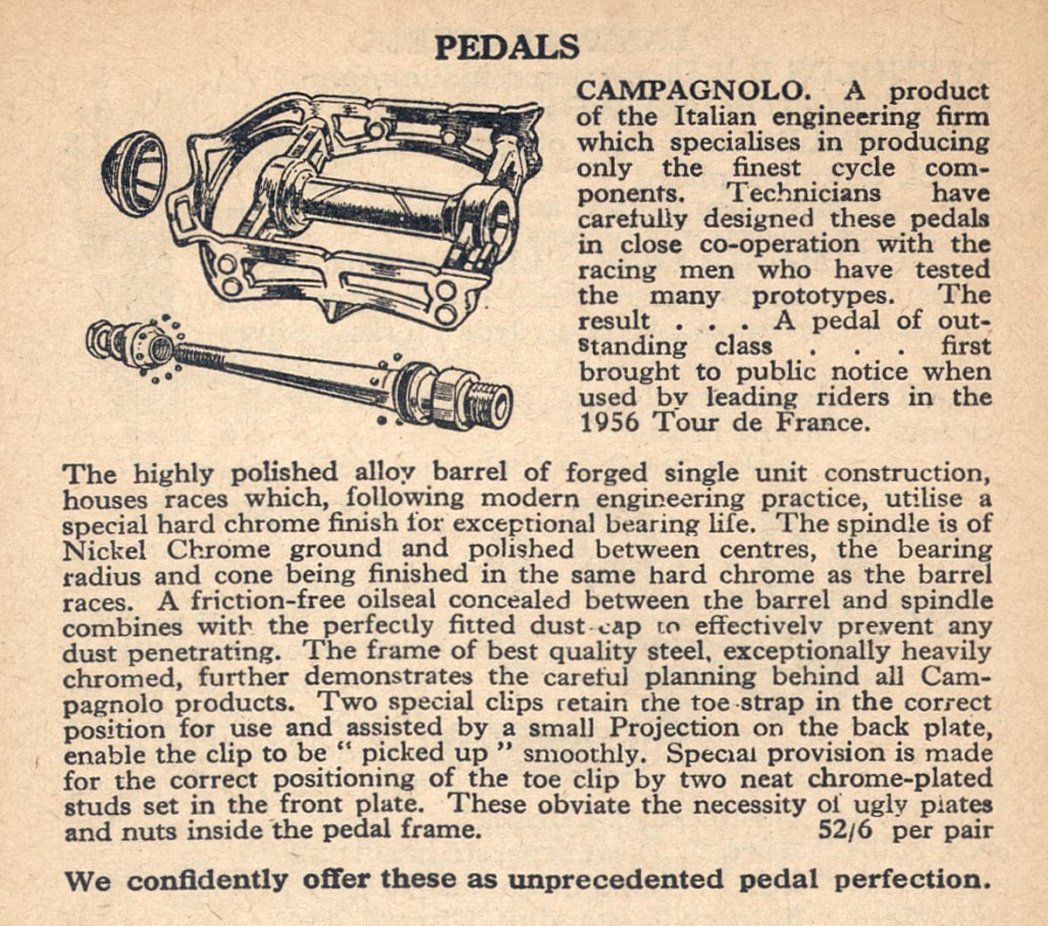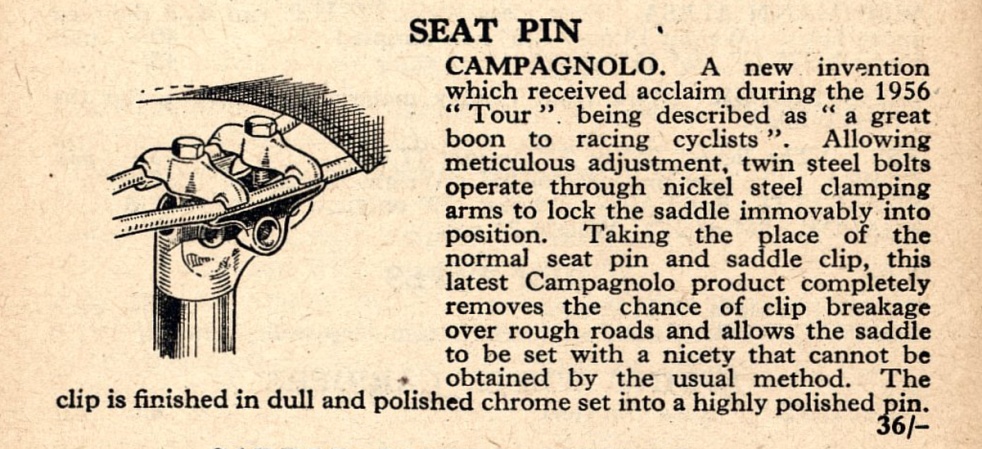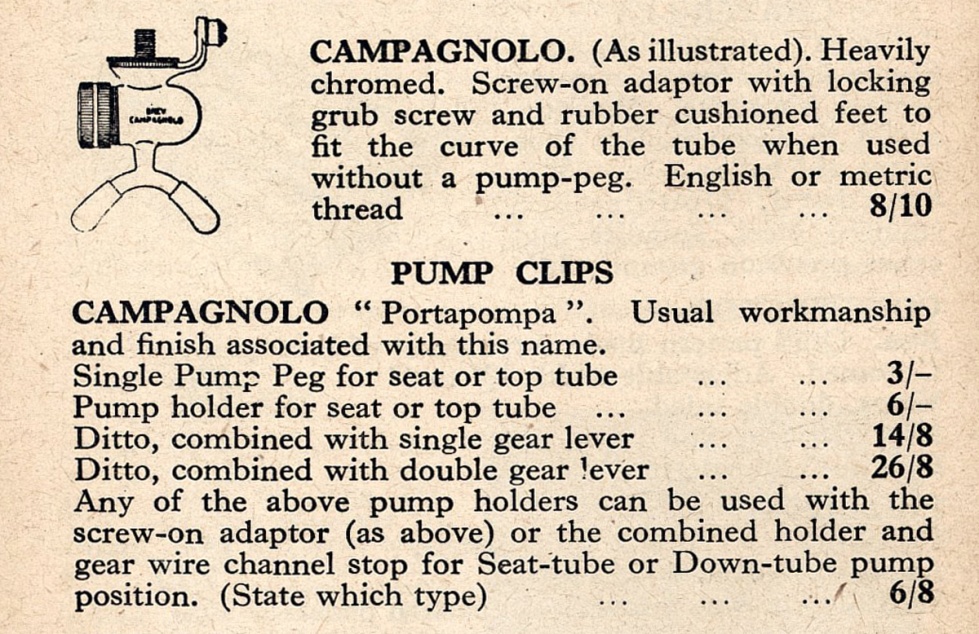Vol. 2, Issue 73 - January / February 2018
Posted: Tuesday 16th January 2018
Yet another year has slipped by, so it is time to wish all of our readers a Happy New Year, good health, and many enjoyable miles of cycling in 2018. I do realise that not all readers are lucky enough (or don’t have the inclination) to be able to carry on cycling year after year but I don’t think that the interest ever quite leaves us, and I quite often see people, obviously not cyclists now, whose eyes light up when they see a group or a sporting cyclist ride by. Something unseen and often unsaid passes between viewer and rider, possibly a recognition of a shared passion at some time, sometimes long gone.
I will be clocking up some 8500 miles this year which is slightly less than usual, and I must confess that the greater number of miles are on modern machines, a stripped-down carbon Colnago for summer and a titanium Van Nicholas as a winter bike complete with mudguards and lights for the dull days. I also have a steel Colnago – 2002 Master X-light Competition which does ride quite like a modern machine. We ride our classics in events for classic bikes, some local, some national and most years one ride abroad.
Last year it was the Anjou-Velo in France which was an amazing event – two days with four rides on each and at least four refreshment stops with wine, water, food and live entertainment at each. I would feel very pleased with myself if I organised a one-day ride with just one stop for refreshments. The French seem to have a knack for this sort of thing. I remember in my sailing days competing in a cross-channel race to Brittany from Cornwall where we were met at the finish by the local town band and the mayor all ensconced in a collection of wobbly-bottomed rubber dinghies. For the band must have been akin to playing the trombone or large base drum standing on top of a wobbly jelly. This went on for many hours as boats finished at different times all day, it being a handicap event. That evening the lifeboat was taken out of the lifeboat house to a mooring in the bay to allow for a full evening’s entertainment – I can’t imagine the Royal National Lifeboat Institution allowing this!
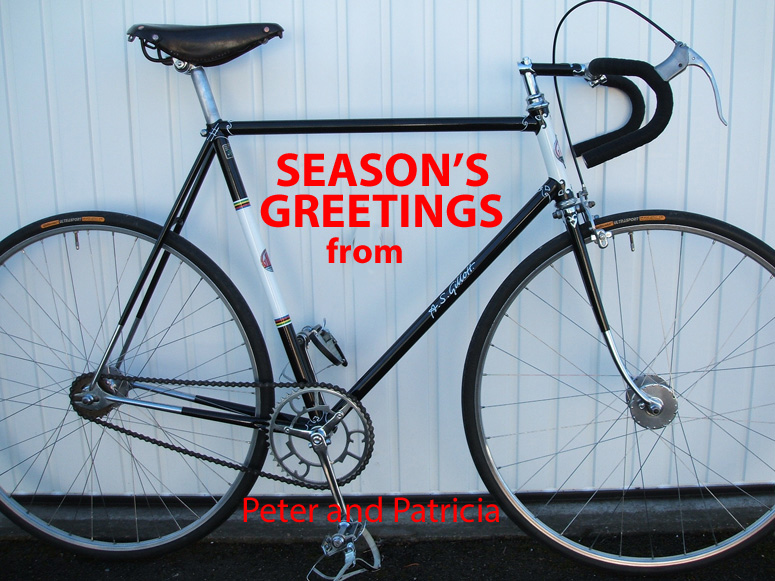
Many enthusiasts don’t like the modern carbon bikes and I think this is due to the fact that modern carbon frames are not constrained in design by the need to join up steel tubes which just about dictates the traditional triangle format beloved by many. Carbon offers the chance to be much more innovative and although the ‘shadow’ of the triangle remains it can be enhanced by what could be called sculptural designs to increase lightness, stiffness and the flow of air over the frame. Weight can be moved from non-stressed areas to beef up stiffness in the bottom-bracket area where the power is exerted.
A by-product of this is the ability to produce frames for women riders – Patricia has a virtual 44cm frame with an actual 37cm seat tube. In the 40s, 50s and subsequent years it was almost impossible to get a frame built smaller than 19” (or 48cm) which is the size of most of her classics. We met Eileen Sheridan once and she was bemoaning the fact that although she was riding for a professional bike building concern (Hercules Cycles) she never felt comfortable on the bike and said that just as soon as she got used to a position they would alter the stem or the bars and she would have to get used to it all over again. You can see that the saddle is just above the top tube. You can see that she is expected to spend all the time down on the drops as the brakes are set low down and not in a position to encourage ‘riding on the tops’.
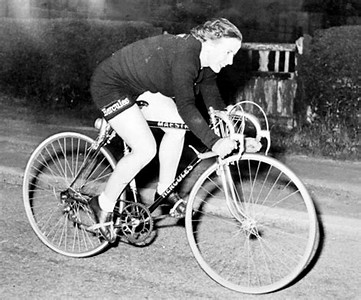
The extreme position can be seen photograph above of Eileen on her record-breaking attempts with bars that had been lowered in the Hercules factory to get a more aerodynamic position (although it was never called that back then!). The bars were no doubt filled with sand in the workshops and reshaped ever lower, as she described.
I suppose the machines to annoy the ‘purist’ most are modern time-trial bikes where aerodynamics rule, which combined with extreme tri-bar set ups can produce some machines as far from the traditional as can be imagined – but watch this space, development carries on and even when you think that must be the extreme, soon it will yesterday’s history.
“We’re flattered by the level of curiosity and goodwill this revival is inspiring. Led by an ex-pat Brit, our Anglo-American team is in the early stages of work on a catalog of components. We’re unveiling details carefully in the interest of over-delivering on expectations. In the coming months we will welcome your feedback on our initial product designs.
Until then, what we can share is this: we are passionate about British cycling heritage, UK manufacturing, and world-class design and engineering. We believe the current climate provides excellent conditions in which to reintroduce a celebrated brand rich in history, heritage and innovation.
News is scarce at the moment but it is possible to enroll for their newsletter on the website https://chaterlea.com/
This reminds me, what happened to the GB components relaunch? I hear nothing about it nowadays and a quick Google search came up with nothing. I wonder how people will react to modern versions of the old classic components, I suppose if they are accurate enough some will be comfortable with them.
The classic image several pages below of Brian Curtis shows a stopwatch mounted in a Cyclo clip on the handlebars. This was quite rare in the 40s/50s as many cyclists of the day just could not afford such a luxury. Now, when riding we all have wrist watches, time on our phones and also on the bike-mounted computer while at home just about every electrical item – computers, ovens, radios, televisions, etc. have the time indicated, often radio controlled so accurate to milliseconds. Thinking back to my youth I didn’t have a watch either on my wrist or on the bike. At home I had a Mickey Mouse alarm clock in my bedroom (when Mickey’s hand is on the two.) and a clock on the living room mantlepiece, nearly always a wedding present, and that was it. It makes me wonder how I always got to venues on time and may explain why I am always ten to fifteen minutes early even to this day. I guess we always knew how long it took to get anywhere plus the fact that there were many public clocks that were set to the correct time.
I researched on Classic Lightweights some information on Odette Coates.
Surprise surprise, when I looked at the photos of the Tom Maysh shop front I saw my father cleaning the windows, yes it was my father Jim Hirst. I remember watching them cycling on that machine and noticed my next door neighbour in the photo (Kenny Rayfield). We were about 8 yrs old, in fact. I also had a photo of us kids standing outside Tom’s shop until I sent it to the Palmers Green Gazette as they wanted old photos at the time of the millennium to keep in their archives.
I lived in Russell Road during the war and until 1950. My father cleaned many shop windows and houses in that area including Oscroft’s, who also sold bikes. I remember Dad and Mum buying me a Sun bike for Christmas and believe it was from Tom Maysh’s shop. Tom was a very nice chap and in the photo of him riding the penny-farthing that is how I remember him. They were good memories but unfortunately most have passed away now. Arthurjimbo@aol.com
THE CLASSIC CYCLIST’S 2018 NEW YEAR QUIZ
Compiled by Wingnuts
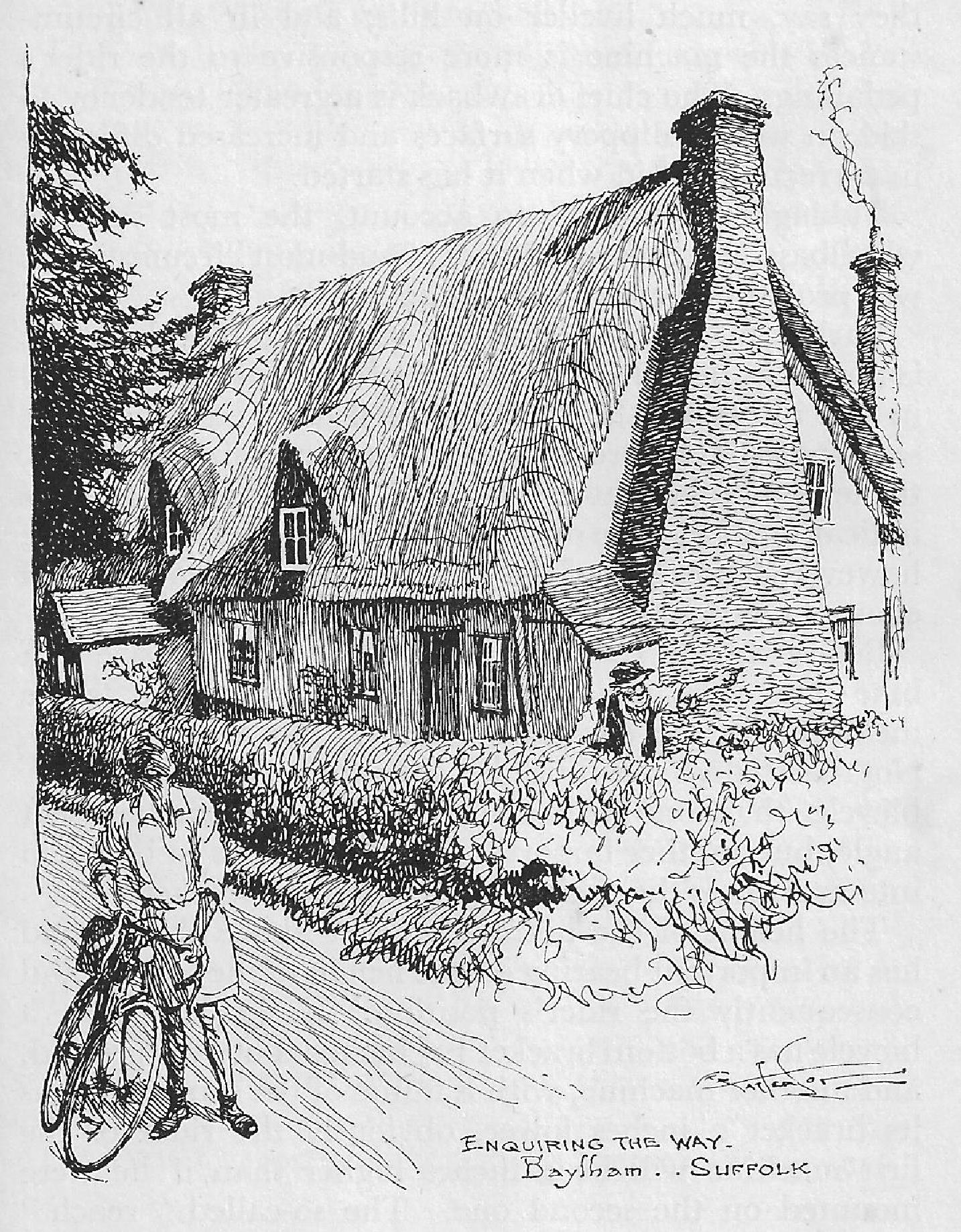
Artwork by Frank Patterson
[Each question is worth 2 points with the exceptions of Q.11(5), Q.14(4) and Q.21(3)]
Total for 22 questions: 50 points
1. What is the formula traditionally used in the Anglophone cycling world to calculate a bicycle’s gear ratio in inches?
2. Which one of the following Italian lightweight builders sponsored the 1950 Tour de France winner, Swiss rider Ferdi Kubler?
a) Frejus b) Atala c) Olmo d) Bianchi e) Cinelli f) Pogliaghi g) Legnano
3. Johnny Berry was a British lightweight frame builder based in:
a) Liverpool b) Manchester c) Leeds d) London
4. In which year did the leading British time trial rider of the day, Ray Booty, win the Commonwealth Games en ligné road race?
a) 1954 b) 1958 c) 1962 d) 1966
5. Who won the first post-WWII Tour de France in 1948?
a) Hugo Koblet b) Jean Robic c) Roger Walkowiak
6. What type of event is the classic Australian ‘Austral Wheel Race’?
a) Track race b) Mass start road race c) Individual road TT
7. Which one of the following independent sponsors did Ian Steel, winner of the eastern-bloc ‘Peace Race’ in 1952, ride for in the 1950s?
a) Ellis-Briggs b) Viking c) Elswick-Hopper d) Wearwell e) Dayton
8. On which French mountain pass is the Tommy Simpson memorial located?
a) Galibier b) l’Izoard c) Ventoux d) Col du Vars e) Alpe d’Huez
9. Which winter sport did the British pre-WWII track stars, brothers Dennis and Cyril Horn, pursue to keep fit?
a) Snowboarding b) Skiing c) Ice skating d) Ice hockey
10. How many times did the Frenchman, Jacques Anquetil, win the Tour de France?
a) Three b) Four c) Five d) Six
11. Place the following FIVE Continental road classic ‘Monuments’ in the correct sequence in which they are held annually over the course of the European road racing season. (5 points)
a) Paris-Roubaix
b) Milan-San Remo
c) Tour of Lombardy
d) Liege-Bastogne-Liege
e) Tour of Flanders
12. Which brand of French lightweight did the Irish professional rider, Seamus Elliott, ride during his continental cycling career?
a) Lejeune b) Helyett c) André Bertin d) Peugeot e) René Herse f) Stella h) Mercier
13. How many times did the British cyclist, Hugh Porter, win the World Professional Individual Pursuit title?
a) Two b) Three c) Four d) Five
14. Which TWO of the following were not Italian lightweight builders? (4 points)
a) Masi b) Cilo c) Wilier d) Gios e) Atala f) Rossin g) Urago
15. In which year was the Yellow Jersey first awarded to the race leader in the Tour de France?
a) 1912 b) 1919 c) 1921 d) 1924
16. In which one of the following 1951 Italian one-day classics did Fausto Coppi’s brother, Serse, die after crashing on tramlines in the closing stages?
a) Milan-San Remo b) Tour of Lombardy c) Tour of Piedmont d) Milan-Turin
17. When was the first multi-stage British ‘Milk Race’, sponsored by the Milk Marketing Board, held?
a) 1956 b) 1957 c) 1958 d) 1959
18. Which one of the following riders with the surnames prefixed by ‘Van’ was not a Belgian?
a) Van Looy b) Van Steenbergen c) Van Vliet c) Van Impe
19. With which brand of lightweight was the British 1960s short distance road TT star, Alf Engers, associated?
a) Condor b) Rotrax c) Shorter d) Ephgrave e) Claud Butler
20. What animal was the noted Cycling Weekly cartoonist, Johnny Helms, famous for including in his cycling cartoons?
a) Dogs b) Cats c) Monkeys d) Horses
21. Who were the THREE British cycling personalities whose surnames’ initials formed the basis for the brand of ‘MKM’ lightweights built from 1972 onwards? (3 points)
22. How many times did Reg Harris win the World Professional Match Sprint title during the period from the late-1940s into the 1950s?
a) Two b) Three c) Four d) Five
Total possible score: 50 points
I wondered if you would be interested in the following? Sturmey Archer ‘dedicated’ triggers for ASC hubs are fairly difficult to obtain nowadays, but all is not lost. One solution is to modify a standard 3 speed trigger, for which there is practical information ‘out there’. Another (and fairly well known) solution is to use a 4-speed trigger, adjusting the indicator with trigger in position 2. This gives the three gears in positions 1, 2 & 4. Position 3 gives a ‘no drive’ situation. Personally, this is my own favoured combination, as the ‘no drive’ position enabled securing crank arm to chain stay when ‘off road’ thus reducing damage to those boulders etc. that crop up frequently, in the wrong places! The pedals and crank arms benefitted too! I always resisted engaging position 3 when riding, as a sure-fire way to the early demise of the internal dogs, if the adjustment wasn’t quite right. Another solution, and not so well known, is to swap the ASC indicator (K807) for K804, 4 speed version (and much more readily available). Now, using 4-speed trigger and adjusting indicator in position 3, (as for a 4-speed hub), One gets 1/2&3/4, for the 3 ASC gears, positions 2 and 3 both giving the middle gear, and drive in all positions. A safer alternative. Cheers.
CAMPAGNOLO PEDALS 1957
Other Campagnolo items for sale in 1957 included this screw-on adaptor and a range of pump clips, also this revolutionary seat post which obviated the use of the multi-piece seat clips on offer that tended to have a mind of their own when assembled. This seat pin does have one quirk of its own, which is trying to fit a spanner on the 8mm nuts that when assembled with the saddle were way up underneath, giving only a few degrees of movement for the spanner. The image below is shown with the saddle cut away. I managed to find a small double ended spanner with ratchet operation that made the job easier.
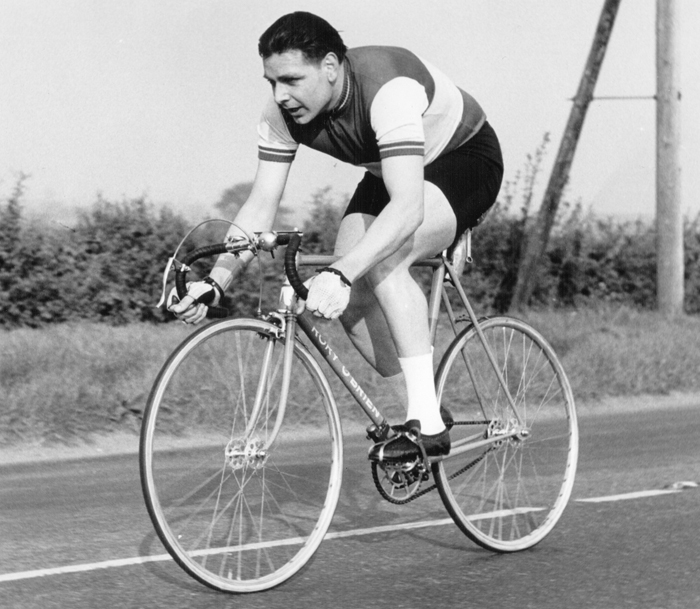
Memories of Cycling in the Fifties by Bernard Howard
I left School in 1949 when I owned a pseudo sports bike and with two friends decided on a great adventure, a 14-day tour of the Lake District using Youth Hostels for accommodation. I knew it would be a bit hilly so I had a brainwave and added a 3-speed Cyclo derailleur to my 3-speed Sturmey hub gear. It worked so I had nine gears now. We really didn’t know what to expect but nevertheless we made it, cobbles, tramlines, the dreary smoky Midlands and all. What an eye opener and what hills!!!! On our return journey South we met the `Brighton to Glasgow Race` peleton heading North. They must have been having a quiet spell because they had plenty of breath to shout friendly ribald remarks in our direction. We must have looked right wallies.
After that I was not earning much money, wages were £3 per week, and I was living in Dagenham with a job in the City and travelled on the Underground where we were packed like sardines, so I decided to ride a bike to work instead. I soon found that the road to London was full of blokes, old and young, cycling to work, I suppose all as skint as me.
A lot of the youngsters I knew were leaning towards club cycling so I decided to get a ‘decent bike’ and join a club with them. In those, what in retrospect, were very drab times the finish on Harry Rensch’s Paris frames was ‘eye-catching’ to say the least, so I was hooked. The price of a frame was about 4 weeks wages, so ‘on the book’, at Rory O`Briens in Manor Park. Complete bikes were subject to Purchase Tax so the only option was to buy the bits and put them together yourself, I even built my own wheels. (Sorry Dave Bedwell, he was the wheel builder at Rory’s).
So now I owned a Paris ‘Professional’ welded frame, which was the cheapest Harry did, and it was brightly finished in Red White and Blue. I fitted an Osgear 5-speed with Gnutti double chainset (with genuine cotter pins as I couldn’t afford the new-fangled cotterless). Yes, you could use a double ring with an Osgear 5, contrary to comments elsewhere. I had a Simplex front changer, Gnutti hubs, San Georgio rims (with serrations on the braking surface), the noise was frightening every time you applied the brakes, D’Allessandro Leone tubs, South of France Bars, which were awful so I soon changed to Coppi. As you can see I used all the cheapest stuff available except for the Brooks B37 saddle which was ‘blocked’ for more comfort. (B37 similar to B17 except for an alloy frame which was lighter.) So, here I was, up and running, cheap and cheerful, and mechanically a lot more knowledgeable.
(Ed. I asked Bernard to explain ‘blocking’, here is the reply: I never actually saw it done, or by who, but saddle went away somewhere to be reshaped at the back, i.e. slightly more rounded. The back of B17’s were fairly square or flat looking, the ‘blocking’ rounded off the rear profile slightly, that little bit more for comfort. Possibly this was arranged at shop when I bought it. Most likely done by some ‘Fred Dibnah’ in his shed with a block of wood and a big hammer !!!!! I can’t imagine Brooks doing it. I just cannot remember where the idea came from, one of those ‘fashions’ that does the rounds. Couldn’t have been ‘too’ drastic otherwise the saddle shape would eventually have suffered. I think the ‘Ideale’ saddle had that sort of rounded profile as bought but I am not certain.)
I joined the ‘Barking Rotrax’ club, (NCU – The Union) and rode a few novice Time Trials but was ‘pathetic’. 0ne of our number rode the ‘Glendene Novices 25’ on the A13 and did a long 59 minutes. That raised a few eyebrows of disbelief, although we knew he was well capable. We watched the massed start racing at Matching Green Airfield which was a Bloody carnage and I decided to give it a miss as I wanted to live a bit longer.
One race we watched c1950 was won by an Australian, Jack Hoobin. He was riding a borrowed bike using a single free wheel!! The same, or following year he won the Amateur World title, again I believe on a single-speed machine. Jack Hoobin apparently became a well known political figure in Australia and, so I was told by a Museum in Australia, was due to open the Olympic Games in Sydney but passed away shortly before the ceremony. I have an idea his wife did the opening instead. He must have been quite a character.
Nevertheless, I rode a race at Brands Hatch at Easter 1950. It snowed and everybody was falling off so I packed in after about 3 laps. Later on I rode a time-trial from the George public house at Wanstead to Cambridge and back, which was 100 miles plus, on what turned out to be the hottest day of the year. By the time I got back to Epping, where there was a lovely inviting horse trough, I was just about all in; and to add insult to injury a young local lad rode slowly up alongside and asked me if I was racing. Just about made it back to the ‘Alpha’ café. Where did I finish ? I don’t know and didn’t care.
My daily cycling routine was to ride from home to work and back, then after work from home to the Café in Romford, where we met the boys for a burn up and down the Southend Arterial road and then back home which altogether totalled about 60 miles each day. Sometimes for a change we went up the Epping Road via the Alpha, another café, to Ma Thompson’s café at Potter Street. This was a really old and famous hang-out, well known to all East London cyclists for years. The return journey was hairy to say the least. It was pitch black with 40 or 50 riders hurtling through the Forest roads with only dim Ever Ready lights. I don’t remember anyone getting killed, but how they didn’t I have no idea.
On Saturdays we rode off to Rory O`Briens where we all met up to ogle all the ‘goodies’. Sometimes he insulted us but he was a lovely bloke really. Sundays were either racing or training rides usually round about 100 miles. So, this all added up to a regular weekly mileage of around 400 plus.
Soon we became aware of this other organisation, the BLRC (the League) which we found very appealing with regard to proper road racing and decided to form our own Club, the Avenue CRC, so named because that was the name of the café where we all hung out, and the fact that the owner agreed to subsidise our ‘woolly jerseys’. You know the ones, alright in the dry but a foot longer in the wet. I had traded in my Paris by now for a CNC which was not so flashy!!
By now we felt that we belonged in the cycling fraternity rather than being on the fringes. We were mixing and riding with the big boys. To give you an idea of the popularity of club cycling, I don’t know how many NCU Clubs were in the London area, but in the BLRC 1951 Handbook there were 45 League Clubs in London alone. Our ‘opening weekend’ training run was to Cheddar and back, which was 120+ miles each way and was more of a road race than a training run!! The Romford RC (Dave Bedwell’s mob) went even further than this, to Exeter and back, which was about 180 miles each way, so we didn’t fancy joining them.
We had week-long tours to the West Country with about £3.50 in our pockets, again more like a stage race and woe betide anyone who got left behind, well not quite that bad but you couldn’t hang about. Our accommodation was usually in a haystack or a ‘barn full of rats’, it actually happened and we spent all night chasing them with torches!
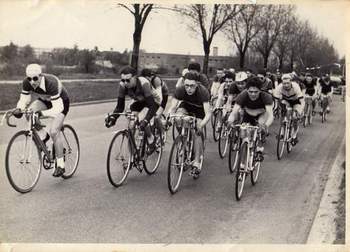
By now, 1951 was the year of the ‘Festival of Britain’. Everything seemed a bit brighter after the austere post-war years and we were entering various junior road races, mainly in Kent where there were more hills than we were used to in Essex. A vivid memory is of one race which was whittled down to about five of us and halfway up Crockham Hill near the finish a certain chap named ‘Jock’ Andrews changed up to a higher gear and rode away. I actually stopped breathing trying to keep up and nearly died but I came in fifth. A few years later Jock Andrews was riding the Tour de France. I’m glad to say I beat him a few months later in the London Junior Championships. I came 2nd by a tyre outside Vic Humphrey’s shop in Lady Margaret Road, Southall. Jock unfortunately fell off somewhere down the road and Didn’t see him again, shame. Bernard 2nd from left in the Herts Grand Prix (Junior)
A few months later I joined the RAF for three years and found other interests, beer, darts and women, as one does. Luckily, I still did a fair bit of riding burning off the locals on their training runs and riding back down the A5 from Bletchley to Romford on ‘Sports afternoons’ but didn’t get much decent competitive riding. After my three years I was demobbed, got married, took on a mortgage and had a family. Need I say more? Like many of my contemporaries I couldn’t get the miles in and then came the end of the BLRC so I decided to pack in competitive riding.
Other snippets:
Whilst in the RAF in 1953, one Sunday on the way back to Hereford Camp from London, on a motor bike, I caught up with a cyclist around Gloucester. I recognised him immediately as Dave Robinson (Romford RC/Independent) so I pulled up alongside him and asked him where he was going. It turned out he was on his way back to his RAF Camp at St Athan’s in South Wales, from Romford in Essex. That is some ride. Mind you, he had ridden in the Tour of Britain a couple of times.
I first saw Dave Bedwell on the grass track, then he went from 3rd Cat to Independent in 2 years. He was a lovely bloke, one of the boys. He burnt his hand dropping fireworks down the chimney of the ‘motorbikers’ café opposite ours, friendly rivalry! I could have made a fortune betting on Dave – if it was a sprint finish he won and if it was a hill-prime he won. He eventually moved to Devon and I was told recently by the Devon CTC that he was on a Club run when he collapsed, shades of Beryl Burton.
The familiar cry ‘Bring out your Dead’, mentioned in another article as used by cyclists in Blackpool! It was the same in Romford, how did this get up North, or how did we get it down South?
There is a photo elsewhere on your site of the finish of a time trial on the Southend Road in 1948 with no traffic in sight. Even in 1951 it was no different, in fact there were very few cars on the road at all. The open road was ours, you could go wherever you wanted with no thought at all of other traffic, happy days.
APC Bowles, Importer, (mentioned elsewhere on the site) was known to us as ‘Johnnie Bowles’. He lived in a student house in East London in his early importing days. We would visit him to see what ‘goodies’ he had acquired. This broadened my sheltered education no end, semi-naked ladies running up and down the stairs and a recital of ‘Eskimo Nell’ that went on for about half an hour. Perhaps that is why we kept going back for more!
I remember spending all night riding round in London waiting to see the start of the 1951 London – Holyhead BLRC Race. We did it again for the Tour of Britain. We also went to Herne Hill to see the great Fausto Coppi on his first visit. With hundreds, if not thousands, of London Italians in the crowd it was electric.
I must mention the story of one of our locals who went to France and Belgium for a taste of Continental racing. He finished up in ditch and when he came round one of the local peasants was trying to straighten his frame out for him. Yes, you’ve guessed, it was a Curly Hetchins. I don’t know the end of the story, sorry.
When I was riding most of us only had one bike which was used for riding to work, training, and racing. To get to the start of a race you rode there, no lifts in cars so you were ‘cream-crackered’ by the time you got home. In the winter we would change to heavier tubs, does anyone remember the Wolber Reds, the ones that used to split down the middle? We used tyresavers all the time and honestly I don`t remember getting many punctures at all.
Does anyone remember a framebuilder in East London called ‘Jimmy Long’? My wife had one of his frames, it was a lovely bike and I last heard of it in the loft of a Southend Wheeler! There was a phase we went through of having a frame built and leaving it ‘as was’ with no paint, just a coat of lacquer, the idea was to save weight and was very elitist.
Bernard Howard aka ‘Bean’, ex-Avenue CRC
I am restoring my late fathers 1935 Claud Butler and am seeking help to get a replacement fork.
The blades fitted to the bike when I started using it in 1963 were as per the photo (which is not from the bike concerned) unfortunately the steerer thread was worn and I substituted some other forks as a temporary measure since then I have lost the original forks.
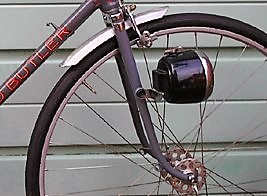
I would like to find someone who has forks of the same profile/dimensions; 7/8″ (22mm) diameter round blade, (26″ wheel not vital it’s the curve that’s important), 2″ off-set / rake and can and will measure or trace the profile of the blades so that Reynolds can check to see if they still have the tooling to reproduce the blades for me.
I would be much obliged if you could help in any way such putting me in touch with an owner or other source of information on the subject. I would of course like to find some of these forks for sale but think that is unlikely.
ANSWERS TO THE CLASSIC CYCLIST’S 2018 NEW YEAR’S QUIZ
Compiled by Wingnuts
[Each question is worth 2 points with the exceptions of Q.11(5), Q.14(4) and Q.21(3)]
Total for 22 questions: 50 points
1.
Example: 48/16 X 27 = 81”. The result in inches shows what the diameter of the front wheel of an old ‘Ordinary’ would have to be to achieve the same gearing.
2. a) Frejus.
The Frejus brand of lightweights was first established in Turin in 1896. In the immediate post-WWII period the Frejus pro trade team was one of the strongest in Italy, rivalling Fausto Coppi’s Bianchi squad and the Legnano team lead by Gino Bartali.
In the 1950 Tour won by Kubler, the Belgian, Stan Ockers, finished second overall and the Frenchman, Louison Bobet, third. Kubler took the race lead after the entire Italian national team with Fiorenzo Magni in yellow withdrew when their riders were attacked by spectators on the road following allegations that Gino Bartali had impeded the Frenchman, Jean Robic, on a climb. Kubler declined to wear the yellow jersey on the day after the Italian team’s withdrawal.
3. b) Manchester.
Johnny’s shop was located in the Rusholme neighbourhood close to the iconic Fallowfield track.
4. b) 1958.
Ray Booty triumphed in the Cardiff Commonwealth Games road race in which Australia’s Frank Brazier finished second and Stuart Slack of the Isle of Man third.
5. b) Jean Robic.
Robic was riding for the regional French ‘West’ team in the 1948 Tour and attacked the overall race leader, Italian Pierre Brambilla, on the final stage to win overall in Paris without ever wearing the yellow jersey. The French national team rider, Edouard Fachleitner, finished second overall and Brambilla third.
6. a) Track race.
Held annually since 1887, The Austral is the world’s oldest track race. A handicap race, originally held over three miles and latterly over 2 000 metres.
7. b) Viking.
Originally established in Wolverhampton in 1908, Viking lightweights achieved fame in the period immediately following WWII when the company began sponsoring a team of independents in Britain. Ian Steel won the 1951 Tour of Britain as a team member before going on to win the Peace Race in 1952.
8. c) Ventoux.
Tommy Simpson collapsed and died on stage 13 on July 13th in the 1967 Tour de France on the Alpine Ventoux climb which was included in the stage from Marseilles to Carpentras.
According to a report in the International Express , May 17, 2017 (page 3), on a recent visit to Luxembourg, ‘Kate … the Duchess of Cambridge … in Luxembourg City’s Place Clairefontaine … attended a cycling-themed festival and unveiled a mural to one of Britain’s greatest cyclists, Tommy Simpson – who died while racing in the Tour de France’.
9. c) Ice skating.
‘…Dennis was undoubtedly heavily influenced by his older brother Cyril. Cyril had started his sporting career as a speed ice-skater in the Fens, going on to win National Championships and to represent the UK in the 1924 Winter Olympics. In common with other skaters in Europe, Cyril later took up cycling to keep himself fit in the summer months, as both sports use similar muscles.’ (Source: Peter Underwood, 2013, Dennis Horn-Racing for an English Rose, p.20).
10. c) Five (1957; 1961; 1962; 1963; 1964).
11. Correct order:
b) Milan-San Remo.
e) Tour of Flanders.
a) Paris-Roubaix.
d) Liege-Bastogne-Liege
e) Tour of Lombardy.
The first four are all early season events while the last is held in autumn.
12. b) Helyett.
Elliott was a trade team-mate of Jacques Anquetil in the early 1960s. He became the first Irish rider to lead the Tour de France when he wore the yellow jersey for three days in the 1963 event.
13. c) Four. (Rome 1968; Leicester 1970; Marseilles 1972; San Sebastien 1973).
14. b) Cilo (Swiss-built lightweight)); g) Urago ( built in Nice, France).
15. b) 1919.
Eugène Christophe was presented with the first ever yellow jersey when leading the Tour at the start of the sixth stage from Bayonne to Luchon. However, when his front forks broke on a subsequent stage he lost time and with it the race lead. The final overall race winner was the Belgian, Firmin Lambot, with Christophe third.
16. c) Tour of Piedmont.
17. c) 1958.
The event was won by Richard Durlacher of Austria.
18. c) Arie Van Vliet was a Dutch track match sprinter and rival to Reg Harris.
Van Vliet’s pro racing career began in the 1930s and continued post-WWII. He was World Professional Match Sprint Champion in 1938, 1948 and 1953.
19. c) Shorter.
Alan Shorter was a North London frame builder specialising in building lightweight TT machines characterised by extensively drilled-out components – seat pillars, brakes, chainsets – and even slots cut into the framestays and forks.
20. a) Dogs.
Johnny’s canines invariably had prominent fangs and were relentless in their pursuit of hapless cyclists.
21. Wes Mason, Ron Kitching; Arthur Metcalfe.
Wes Mason was winner of the 1962 Commonwealth Games road race title; Ron Kitching was a Harrogate-based wholesaler and importer of lightweight equipment; Arthur Metcalfe uniquely won both the 1966 BBAR and British Pro Road Championship. Together they formed a partnership to produce quality hand-built lightweight frames branded as MKM.
22. c) Four. (1949; 1950; 1951; 1954).
Total possible score: 50 points
SCORING
40-50: You are a true classic cycling aficionado!
20-39: You are just safely ‘in the bunch’.
Less than 20: You have been dropped and are in danger of being eliminated.
Posted: Tuesday 16th January 2018
This article appears in the following categories.
Upcoming Events
Whether you are looking for a gentle social meet up, or a 100-mile ride browse the community’s upcoming events and plan your next weekend outing.

